 |  |  |  |
| Corinium Museum, named after the Roman name for Cirencester. Cirencester, England. | Corinium Museum containing artifacts from what is now Cirencester from Neolithic to Victorian times. Cirencester, England. | Corinium Museum contains & explains artifacts from Cirencester & area from Neolithic to Victorian times with particular focus on Roman era. Cirencester, England. | Woolly mammoth tusk found at Cotswold Water Park south of Cirencester. Cirencester, England. |
 |  |  |  |
| Flint blades of various types used for different purposes at Corinium Museum. Cirencester, England. | Deer antler picks grave goods used in Neolithic times to quarry stone & dig pits & ditches found at Hazleton North Long Barrow in Gloucestershire at Corinium Museum. Cirencester, England. | Bronze Age metalwork, made from mixture of copper & tin, consisting of spearheads & arrowhead at Corinium Museum. Cirencester, England. | Bronze Age Hoard, consisting of precious objects, often gold or silver, buried to protect them during dangerous times at Corinium Museum. Cirencester, England. |
 |  |  |  |
| Torc (twisted metal bands) fragments & twisted rods at Corinium Museum. Cirencester, England. | Display of items excavated from South Chamber of Hazleton North Long Barrow at Corinium Museum. Cirencester, England. | Stones used to form chambers & passageways of Hazleton North Long Barrow at Corinium Museum. Cirencester, England. | Roman military pendants & fittings at Corinium Museum. Cirencester, England. |
 | 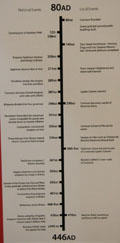 |  |  |
| Roman era street plan of Corinium overlaid with some modern landmarks at Corinium Museum. Cirencester, England. | Time chart of important events of Roman era in Britain (80 - 446CE) side by side with events specific to Corinium at Corinium Museum. Cirencester, England. | Samian ware pottery, imported from Gaul for use by Roman army stationed at fort in what is now Cirencester, at Corinium Museum. Cirencester, England. | Samian ware pottery bowl at Corinium Museum. Cirencester, England. |
 |  |  |  |
| Samian ware pottery bowls at Corinium Museum. Cirencester, England. | Roman era ceramics at Corinium Museum. Cirencester, England. | Roman era pottery vessel with pouring spout at Corinium Museum. Cirencester, England. | Samian ware sherd decorated with scenes of man spearing lion at Corinium Museum. Cirencester, England. |
 | 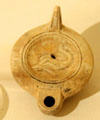 | 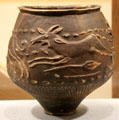 |  |
| Miniature Roman era oil lamps, some found in Cirencester area, at Corinium Museum. Cirencester, England. | Roman era pottery oil lamp with lid decorated with dolphin which was considered a sacred animal at Corinium Museum. Cirencester, England. | Roman era hunt cup with deer hunting scene at Corinium Museum. Cirencester, England. | Roman era flagon necks (vessel used for pouring drinks) decorated with women's faces & their elaborate hairstyles at Corinium Museum. Cirencester, England. |
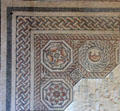 |  |  |  |
| Part of larger Roman mosaic pavement found at Cirencester at Corinium Museum. Cirencester, England. | Mosaic set into floor in changing room of bathhouse in Roman townhouse in Cirencester at Corinium Museum. Cirencester, England. | Mosaic (4thC CE) from Roman townhouse found in Cirencester with hare motif as centerpiece at Corinium Museum. Cirencester, England. | Detail of hare motif centerpiece from Roman townhouse Mosaic (4thC CE) in Cirencester at Corinium Museum. Cirencester, England. |
 | 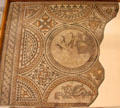 |  |  |
| Hunting Dogs Pavement mosaic named after hounds depicted in central roundel found in Cirencester at Corinium Museum. Cirencester, England. | Detail of Hunting Dogs Pavement mosaic at Corinium Museum. Cirencester, England. | Detail (2ndC) from original Hunting Dogs Pavement mosaic, which had a marine theme, at Corinium Museum. Cirencester, England. | Seasons Mosaic (mid 2ndC) depicting four seasons & scenes from Roman mythology, found in Cirencester, at Corinium Museum. Cirencester, England. |
 |  |  |  |
| Scene from Seasons Mosaic, depicting Silenus, guardian of Bacchus, riding a donkey, at Corinium Museum. Cirencester, England. | Scene from Seasons Mosaic representing summer & depicting Ceres, goddess of agriculture, carrying a sickle at Corinium Museum. Cirencester, England. | Scene from Seasons Mosaic representing Spring & depicting Flora, goddess of flowers, wearing a garland at Corinium Museum. Cirencester, England. | Roman mosaic detail at Corinium Museum. Cirencester, England. |
 |  |  |  |
| Orpheus Mosaic (4thC) showing Orpheus charming animals with his music, found just outside ancient Corinium at Corinium Museum. Cirencester, England. | Orpheus Mosaic at Corinium Museum. Cirencester, England. | Orpheus Mosaic at Corinium Museum. Cirencester, England. | Section of wall plaster from 1stC shop in Cirencester at Corinium Museum. Cirencester, England. |
 |  |  |  |
| Altar dedicated to Genius Loci, the "Spirit of the Place", found in Cirencester, at Corinium Museum. Cirencester, England. | Altar dedicated to Genius Loci who wears a crown, holds a cornucopia in his left hand, and holds a patera or sacrificial bowl in his right hand. Cirencester, England. | Tombstones from Roman era at Corinium Museum. Cirencester, England. | Copper-alloy enameled cockerel figurine grave good at Corinium Museum. Cirencester, England. |
 | 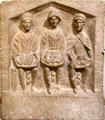 |  |  |
| Part of a decorated lead coffin of Roman era found in Cirencester area at Corinium Museum. Cirencester, England. | Stone relief of three mother goddesses (2nd or 3rdC CE) made of limestone & found in Cirencester at Corinium Museum. Cirencester, England. | Roman steelyard weight in form of portrait of a woman, likely Fausta, wife of Constantine the Great, at Corinium Museum. Cirencester, England. | Engraved copper-alloy disc (2ndC CE) cut from military diploma & silver & copper-alloy coins from Republic & Claudian periods at Corinium Museum. Cirencester, England. |
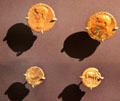 |  |  | 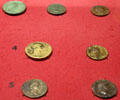 |
| Copper-alloy Roman coins at Corinium Museum. Cirencester, England. | Details of two Roman coins on display at Corinium Museum. Cirencester, England. | Display of Roman coins used in 1st & 2'nd C at Corinium Museum. Cirencester, England. | Display of Roman coins at Corinium Museum. Cirencester, England. |
 |  |  |  |
| Roman weights & measures at Corinium Museum. Cirencester, England. | Three rare pewter vessels from Northleach, not far from Cirencester, at Corinium Museum. Cirencester, England. | Knife handle, Roman era, in form of lion eating its prey at Corinium Museum. Cirencester, England. | Furniture mounts, Roman era, in the form of lions' heads at Corinium Museum. Cirencester, England. |
 |  | 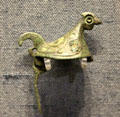 |  |
| Copper-alloy figurine of Lar or Roman household god at Corinium Museum. Cirencester, England. | Enameled horse & rider brooch (2nd & 3rdC CE) found in Cirencester at Corinium Museum. Cirencester, England. | Roman brooch in form of bird (2nd & 3rdC CE) at Corinium Museum. Cirencester, England. | Anglo-Saxon gilded saucer brooches (1st half of 6thC CE) found in grave of child in Lechlade not far from Cirencester at Corinium Museum. Cirencester, England. |
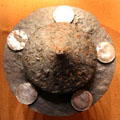 |  |  | 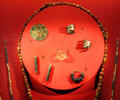 |
| Iron shield boss with silvered rivet-heads (6thC CE) at Corinium Museum. Cirencester, England. | "Mrs Getty's" grave (6thC CE) a reconstruction, including her face, of one of the richest Anglo-Saxon graves ever found in Britain excavated in Butler's Field Lechlade at Corinium Museum. Cirencester, England. | Pair of gilded saucer brooches & "Great square-headed" brooch (6thC CE) found in "Mrs Getty's" grave, Butler's Field Lechlade at Corinium Museum. Cirencester, England. | Objects (6thC CE) found in "Mrs Getty's" grave, Butler's Field Lechlade at Corinium Museum. Cirencester, England. |
 |  |  |  |
| Bead necklaces & beaver tooth pendant (6thC CE) found in "Mrs Getty's" grave, Butler's Field Lechlade at Corinium Museum. Cirencester, England. | Jewelry made of or set in gold found in Anglo-Saxon graves at Corinium Museum. Cirencester, England. | Collection of brooches found in Anglo-Saxon graves at Corinium Museum. Cirencester, England. | Largest pair of saucer brooches (c600 CE) found at Butler's Field Lechdale at Corinium Museum. Cirencester, England. |
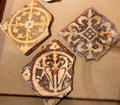 | 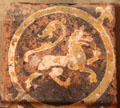 | 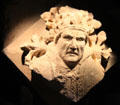 |  |
| Decorated floor tiles from ruins of St Mary's Abbey (1130-1539) located in Cirencester at Corinium Museum. Cirencester, England. | Heraldic floor tile depicting a lion rampant (13thC) from St Mary's Abbey at Corinium Museum. Cirencester, England. | Corbel, jutting out from wall to support something above it, depicting the Pope (15thC) from St Mary's Abbey at Corinium Museum. Cirencester, England. | Shears (13th-14thC) used in wool trade which was basis of Cotswold's economy at Corinium Museum. Cirencester, England. |
 |  |  |  |
| Collection of medieval metal objects at Corinium Museum. Cirencester, England. | Late Elizabethan field helmet converted to an ornament on the tomb of a prominent local Royalist at Corinium Museum. Cirencester, England. | Weston-sub-Edge-Hoard, a Civil War hoard (mid 17thC) of 307 silver & 2 gold coins contained in a specially made pipe beneath floorboards & found in the place for which it is named at Corinium Museum. Cirencester, England. | Alfred Powell Bowl (c1920's) made of glazed earthenware & depicting 4 scenes of Cirencester made by Alfred Powell, an Arts & Crafts designer at Corinium Museum. Cirencester, England. |








